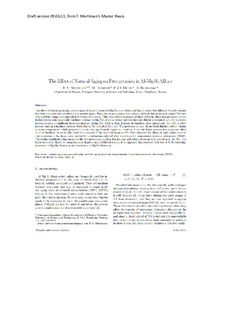| dc.contributor.author | Martinsen, Fredrik A | |
| dc.contributor.author | Ehlers, Flemming J H | |
| dc.contributor.author | Torsæter, Malin | |
| dc.contributor.author | Holmestad, Randi | |
| dc.date.accessioned | 2017-11-06T13:34:53Z | |
| dc.date.available | 2017-11-06T13:34:53Z | |
| dc.date.created | 2012-12-14T21:05:18Z | |
| dc.date.issued | 2012 | |
| dc.identifier.citation | Acta Materialia. 2012, 60 (17), 6091-6101. | nb_NO |
| dc.identifier.issn | 1359-6454 | |
| dc.identifier.uri | http://hdl.handle.net/11250/2464301 | |
| dc.description.abstract | The effect of solute clustering on subsequent precipitation has been investigated for three different Al–Mg–Si alloys with similar Mg/Si ratios but different Mg + Si contents. Hardness measurements were carried out (i) during various natural aging (NA) times at room temperature, and (ii) after a fixed artificial aging (AA) heat treatment preceded by various NA times. Comparison between the two hardness plots stressed an intimate connection between solute clusters and precipitates: for the NA times investigated (between a few seconds and several months), transient phenomena with short (less than 10 h) lifetimes were observed, both occurring at earlier times and with higher relative importance for increasing solute concentration. Upon NA + AA, these transient phenomena were found to be responsible for the well-known “negative NA effect”, as evidenced by a close correlation between the respective lifetimes. In particular, the negative NA effect itself was found to be transient, and was reversed upon long storage times by the dominance of a process beneficial to precipitation. Transmission electron microscopy studies of selected alloy conditions ensured that the recorded hardness variations reflected variations in the alloy microstructure. Attempts were made to couple the transient clustering phenomena with solute strain field interactions. Preliminary calculations following this line of thought suggested a competitive nature of both Mg–Mg and Mg–Si interactions, in contrast with the usual view of Mg–Mg repulsion. An alloy hardness optimization procedure as a function of storage time, temperature and alloy composition has been suggested. | nb_NO |
| dc.language.iso | eng | nb_NO |
| dc.publisher | Elsevier | nb_NO |
| dc.title | Reversal of the negative natural aging effect in Al-Mg-Si alloys | nb_NO |
| dc.type | Journal article | nb_NO |
| dc.description.version | submittedVersion | nb_NO |
| dc.source.pagenumber | 6091-6101 | nb_NO |
| dc.source.volume | 60 | nb_NO |
| dc.source.journal | Acta Materialia | nb_NO |
| dc.source.issue | 17 | nb_NO |
| dc.identifier.doi | 10.1016/j.actamat.2012.07.047 | |
| dc.identifier.cristin | 973530 | |
| dc.relation.project | Norges forskningsråd: 205353 | nb_NO |
| dc.relation.project | Notur/NorStore: NN8068K | nb_NO |
| dc.description.localcode | This is a submitted manuscript of an article published by Elsevier Ltd in Acta Materialia, 4 September 2012 | nb_NO |
| cristin.unitcode | 194,66,20,0 | |
| cristin.unitname | Institutt for fysikk | |
| cristin.ispublished | true | |
| cristin.fulltext | preprint | |
| cristin.qualitycode | 2 | |
